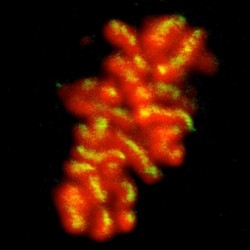By Helen Figueira
November 28, 2012
Time to read: 3 minutes
 Cohesin in DNA repair: more complex than we thought
Cohesin in DNA repair: more complex than we thought
When your oven breaks, you call in a repairman. Once he arrives and goes about his business, it’s important that you get out of his way to let him work, but linger sufficiently close to ensure he doesn’t stray from the task at hand. Deep inside our cells, a protein complex called cohesin does something similar when DNA strands break just after they’ve replicated. When such breaks occur, the easiest route to repair is to use the recently formed copy – the sister chromatid – as a template for rebuilding. It has long been established that to ease this process, cohesin draws and anchors the two chromatids together. New research from the CSC, published online in the journal Nature this week, reveals that this cohesin arrival is a little more complex. Not only is it recruited to hold the chromatids together, but it then also has to get out of the way to allow the repair mechanisms to get to work.
Double-strand breaks occur in our DNA each time cells go through the cell cycle, but we are well equipped with damage repair mechanisms. “The most reliable way to repair the break is homologous recombination,” says Luis Aragon (Cell Cycle), who led the study. “It uses another nearby sequence as a precise guide, and works like ‘copy and paste’ on your computer.” The broken region scrambles for the nearest suitable template DNA sequence. To ensure that the sister chromatid is used, rather than any other less well matched region, cohesin physically glues the two chromatids together.
“This new research shows that in the presence of a break, not only is cohesin recruited, but it is also ejected from the site,” clarifies Aragon. The discovery that cohesin is not just a static anchor changes our understanding of this fundamental process. “The idea of cohesin arriving and holding things together is only partially true. It enters a cycle of binding and unjoining; holding the chromatids together and then dropping off. The reason for this is that to repair the break efficiently, many molecular events take place. Lots of molecular machinery must be recruited to carry out the repair functions, and it seems that if cohesin cannot come out, it physically blocks the machinery. It gets in the way.”
The mechanism by which the cohesin is removed soon after it joins is the cleavage of one of its subunits, known as Mcd1, by an enzyme aptly christened separase. Cohesin, therefore, requires a large supply of renewed subunits to allow it to continue to bind after it has been ejected from the chromatids. This cleavage mechanism is the same as the cell uses at a much earlier phase of the cell cycle, during the metaphase-anaphase transition. How this behaviour is localised during the repair is just one question that this research raises.
Although this work is far removed from any clinical application, Aragon can see its eventual potential. “This is a very basic finding, but you can imagine that it could contribute to therapy development. Treatments, in particular for cancer, sometimes employ agents that cause DNA damage. Understanding cohesin’s role in this, and learning how to intervene, could help make drugs more effective.”
-AL
Reference: McAleenan, A., Clemente-Blanco, A., Cordon-Preciado, V., Sen, N., Esteras, M., Jarmuz, A., Aragon, L., (2012). Post-replicative repair involves separase-dependent removal of the kleisin subunit of cohesin. Nature advance online publication. Abstract
Photo Credit: Available under Creative Commons by-nc-nd 2.0, courtesy Wellcome Images & Matthew Daniels. Human chromosomes in metaphase, with cohesin shown in yellow.